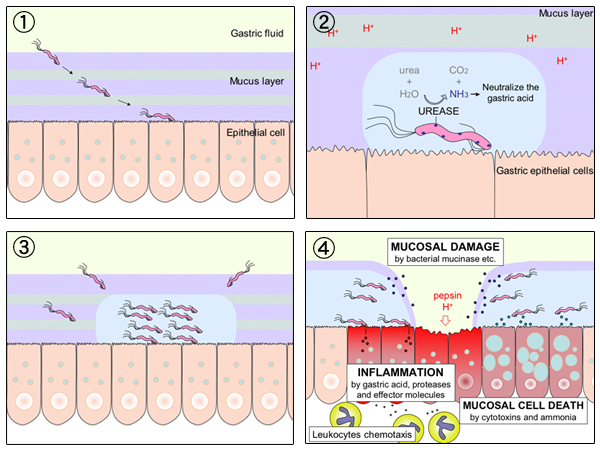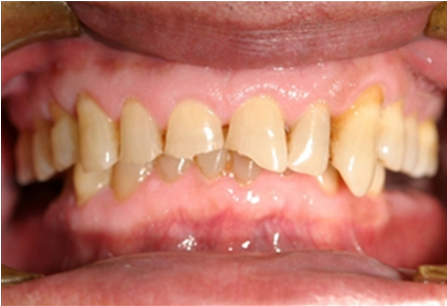|
Dyspepsia
Indigestion, also known as dyspepsia or upset stomach, is a condition of impaired digestion. Symptoms may include upper abdominal fullness, heartburn, nausea, belching, or upper abdominal pain. People may also experience feeling full earlier than expected when eating. Indigestion is relatively common, affecting 20% of people at some point during their life, and is frequently caused by gastroesophageal reflux disease (GERD) or gastritis. Indigestion is subcategorized as either "organic" or " functional dyspepsia", but making the diagnosis can prove challenging for physicians. Organic indigestion is the result of an underlying disease, such as gastritis, peptic ulcer disease (an ulcer of the stomach or duodenum), or cancer. Functional indigestion (previously called non-ulcer dyspepsia) is indigestion without evidence of underlying disease. Functional indigestion is estimated to affect about 15% of the general population in western countries and accounts for a majority of dys ... [...More Info...] [...Related Items...] OR: [Wikipedia] [Google] [Baidu] [Amazon] |
Functional Dyspepsia
Functional dyspepsia (FD) is a common gastrointestinal disorder defined by symptoms arising from the gastroduodenal region in the absence of an underlying organic disease that could easily explain the symptoms. Characteristic symptoms include epigastric burning, epigastric pain, postprandial fullness, and early satiety. FD was formerly known as non-ulcer dyspepsia, as opposed to " organic dyspepsia" with underlying conditions of gastritis, peptic ulcer disease, or cancer. The exact cause of functional dyspepsia is unknown however there have been many hypotheses regarding the mechanisms. Theories behind the pathophysiology of functional dyspepsia include gastroduodenal motility, gastroduodenal sensitivity, intestinal microbiota, immune dysfunction, gut-brain axis dysfunction, abnormalities of gastric electrical rhythm, and autonomic nervous system/central nervous system dysregulation. Risk factors for developing functional dyspepsia include female sex, smoking, non-steroidal a ... [...More Info...] [...Related Items...] OR: [Wikipedia] [Google] [Baidu] [Amazon] |
Helicobacter Pylori
''Helicobacter pylori'', previously known as ''Campylobacter pylori'', is a gram-negative, Flagellum#bacterial, flagellated, Bacterial cellular morphologies#Helical, helical bacterium. Mutants can have a rod or curved rod shape that exhibits less virulence. Its Helix, helical body (from which the genus name ''Helicobacter'' derives) is thought to have evolved to penetrate the gastric mucosa, mucous lining of the stomach, helped by its flagella, and thereby establish infection. While many earlier reports of an association between bacteria and the ulcers had existed, such as the works of John Lykoudis, it was only in 1983 when the bacterium was formally described for the first time in the English-language Western literature as the causal agent of peptic ulcer, gastric ulcers by Australian physician-scientists Barry Marshall and Robin Warren. In 2005, the pair was awarded the Nobel Prize in Physiology or Medicine for their discovery. Infection of the stomach with ''H. pylori'' doe ... [...More Info...] [...Related Items...] OR: [Wikipedia] [Google] [Baidu] [Amazon] |
Heartburn
Heartburn is a burning sensation felt behind the breastbone. It is a symptom that is commonly linked to acid reflux and is often triggered by food, particularly fatty, sugary, spicy, chocolate, citrus, onion-based and tomato-based products. Lying down, bending, lifting, and performing certain exercises can exacerbate heartburn. Causes include acid reflux, gastroesophageal reflux disease (GERD), damage to the esophageal lining, bile acid, mechanical stimulation to the esophagus, and esophageal hypersensitivity. Heartburn affects 25% of the population at least once a month. Endoscopy and esophageal pH monitoring can be used to evaluate heartburn. Some causes of heartburn, such as GERD, may be diagnosed based on symptoms alone. Potential Differential diagnosis, differential diagnoses for heartburn include motility disorders, ulcers, Esophagitis, inflammation of the esophagus, and medication side effects. Lifestyle changes, such as weight loss, losing weight and avoiding fatty food ... [...More Info...] [...Related Items...] OR: [Wikipedia] [Google] [Baidu] [Amazon] |
Gastroesophageal Reflux Disease
Gastroesophageal reflux disease (GERD) or gastro-oesophageal reflux disease (GORD) is a chronic upper gastrointestinal disease in which stomach content persistently and regularly flows up into the esophagus, resulting in symptoms and/or complications. Symptoms include dental corrosion, dysphagia, heartburn, odynophagia, regurgitation, non-cardiac chest pain, extraesophageal symptoms such as chronic cough, hoarseness, reflux-induced laryngitis, or asthma. In the long term, and when not treated, complications such as esophagitis, esophageal stricture, and Barrett's esophagus may arise. Risk factors include obesity, pregnancy, smoking, hiatal hernia, and taking certain medications. Medications that may cause or worsen the disease include benzodiazepines, calcium channel blockers, tricyclic antidepressants, NSAIDs, and certain asthma medicines. Acid reflux is due to poor closure of the lower esophageal sphincter, which is at the junction between the stomach and ... [...More Info...] [...Related Items...] OR: [Wikipedia] [Google] [Baidu] [Amazon] |
Gastritis
Gastritis is the inflammation of the lining of the stomach. It may occur as a short episode or may be of a long duration. There may be no symptoms but, when symptoms are present, the most common is upper abdominal pain (see dyspepsia). Other possible symptoms include nausea and vomiting, bloating, loss of appetite and heartburn. Complications may include stomach bleeding, stomach ulcers, and stomach tumors. When due to autoimmune problems, low red blood cells due to not enough vitamin B12 may occur, a condition known as pernicious anemia. Common causes include infection with '' Helicobacter pylori'' and use of nonsteroidal anti-inflammatory drugs ( NSAIDs). When caused by ''H. pylori'' this is now termed ''Helicobacter pylori'' induced gastritis, and included as a listed disease in ICD11. Less common causes include alcohol, smoking, cocaine, severe illness, autoimmune problems, radiation therapy and Crohn's disease. Endoscopy, a type of X-ray known as an upper gast ... [...More Info...] [...Related Items...] OR: [Wikipedia] [Google] [Baidu] [Amazon] |
Nausea
Nausea is a diffuse sensation of unease and discomfort, sometimes perceived as an urge to vomit. It can be a debilitating symptom if prolonged and has been described as placing discomfort on the chest, abdomen, or back of the throat. Over 30 definitions of nausea were proposed in a 2011 book on the topic. Nausea is a non-specific symptom, which means that it has many possible causes. Some common causes of nausea are gastroenteritis and other gastrointestinal disorders, food poisoning, motion sickness, dizziness, migraine, fainting, low blood sugar, anxiety, hyperthermia, dehydration and lack of sleep. Nausea is a side effect of many medications including chemotherapy, or morning sickness in early pregnancy. Nausea may also be caused by disgust and depression. Medications taken to prevent and treat nausea and vomiting are called antiemetics. The most commonly prescribed antiemetics in the US are promethazine, metoclopramide, and the newer ondansetron. The word na ... [...More Info...] [...Related Items...] OR: [Wikipedia] [Google] [Baidu] [Amazon] |
Belching
Burping (also called belching and eructation) is the release of gas from the upper digestive tract (esophagus and stomach) of animals through the mouth. It is usually audible. In humans, burping can be caused by normal eating processes, or as a side effect of other medical conditions. There is a range of levels of social acceptance for burping: within certain contexts and cultures, burping is acceptable and may even be perceived as humorous, while in others it is seen as impolite or even offensive and therefore unacceptable. Humans are not the only animals that burp: it is very common among other mammals. In particular, burping by domesticated ruminants, such as cows or sheep, is a major contributor of methane emissions and may have a negative effect on the environment. Significant research is being done to find mitigation strategies for ruminant burping, e.g. modifying the animals' diets with '' Asparagopsis taxiformis'' (red seaweed). Causes *Burping is usually caused by ... [...More Info...] [...Related Items...] OR: [Wikipedia] [Google] [Baidu] [Amazon] |
Abdominal Pain
Abdominal pain, also known as a stomach ache, is a symptom associated with both non-serious and serious medical issues. Since the abdomen contains most of the body's vital organs, it can be an indicator of a wide variety of diseases. Given that, approaching the examination of a person and planning of a differential diagnosis is extremely important. Common causes of pain in the abdomen include gastroenteritis and irritable bowel syndrome. About 15% of people have a more serious underlying condition such as appendicitis, leaking or ruptured abdominal aortic aneurysm, diverticulitis, or ectopic pregnancy. In a third of cases, the exact cause is unclear. Signs and symptoms The onset of abdominal pain can be abrupt, quick, or gradual. Sudden onset pain happens in a split second. Rapidly onset pain starts mild and gets worse over the next few minutes. Pain that gradually intensifies only after several hours or even days has passed is referred to as gradual onset pain. One can ... [...More Info...] [...Related Items...] OR: [Wikipedia] [Google] [Baidu] [Amazon] |
Peptic Ulcer Disease
Peptic ulcer disease is when the inner part of the stomach's gastric mucosa (lining of the stomach), the first part of the small intestine, or sometimes the lower esophagus, gets damaged. An ulcer in the stomach is called a gastric ulcer, while one in the first part of the intestines is a duodenal ulcer. The most common symptoms of a duodenal ulcer are waking at night with upper abdominal pain, and upper abdominal pain that improves with eating. With a gastric ulcer, the pain may worsen with eating. The pain is often described as a burning or dull ache. Other symptoms include belching, vomiting, weight loss, or poor appetite. About a third of older people with peptic ulcers have no symptoms. Complications may include bleeding, perforation, and blockage of the stomach. Bleeding occurs in as many as 15% of cases. Common causes include infection with ''Helicobacter pylori'' and non-steroidal anti-inflammatory drugs (NSAIDs). Other, less common causes include tobacco smoking, ... [...More Info...] [...Related Items...] OR: [Wikipedia] [Google] [Baidu] [Amazon] |
Duodenum
The duodenum is the first section of the small intestine in most vertebrates, including mammals, reptiles, and birds. In mammals, it may be the principal site for iron absorption. The duodenum precedes the jejunum and ileum and is the shortest part of the small intestine. In humans, the duodenum is a hollow jointed tube about long connecting the stomach to the jejunum, the middle part of the small intestine. It begins with the duodenal bulb, and ends at the duodenojejunal flexure marked by the suspensory muscle of duodenum. The duodenum can be divided into four parts: the first (superior), the second (descending), the third (transverse) and the fourth (ascending) parts. Overview The duodenum is the first section of the small intestine in most higher vertebrates, including mammals, reptiles, and birds. In fish, the divisions of the small intestine are not as clear, and the terms ''anterior intestine'' or ''proximal intestine'' may be used instead of duodenum. In mammals the d ... [...More Info...] [...Related Items...] OR: [Wikipedia] [Google] [Baidu] [Amazon] |
Cholecystitis
Cholecystitis is inflammation of the gallbladder. Symptoms include Right upper quadrant (abdomen), right upper abdominal pain, pain in the right shoulder, nausea, vomiting, and occasionally fever. Often gallbladder attacks (biliary colic) precede acute cholecystitis. The pain lasts longer in cholecystitis than in a typical gallbladder attack. Without appropriate treatment, recurrent episodes of cholecystitis are common. Complications of acute cholecystitis include gallstone pancreatitis, common bile duct stones, or cholangitis, inflammation of the common bile duct. More than 90% of the time acute cholecystitis is caused from blockage of the cystic duct by a gallstone. Risk factors for gallstones include combined oral contraceptive pill, birth control pills, pregnancy, a family history of gallstones, obesity, diabetes, cirrhosis, liver disease, or rapid weight loss. Occasionally, acute cholecystitis occurs as a result of vasculitis or chemotherapy, or during recovery from major tr ... [...More Info...] [...Related Items...] OR: [Wikipedia] [Google] [Baidu] [Amazon] |







